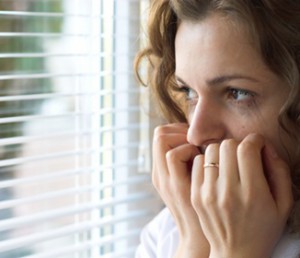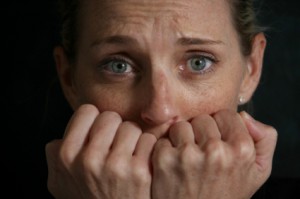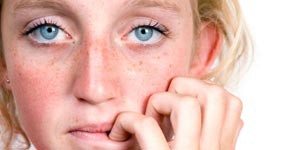Anxiety can arise by false beliefs of as religious teaches us, that God has power and is self and has control over telepathy and magic powers, cause if so, then why does God allow us to suffer? As water is as sperm and as it comes from the moon and as the moon is sometimes seen and sometimes not then ghosts can be seen as connective with eachother.

Ghosts are sometimes seen but not always, as the moon. So as ghosts are of detachment as the moon is opposite of the sun, then there is no concentration in ghosts and so the whole world was created by coincidence as ghosts that enter beengs are like a man entering a woman and making a child. It is the beginning of life itself. When the ghostly energy just as a child in the womb with the spine created is downwards so the moon or similar energy fell downwards to sleep and the mountains crashed creating fire. Because magic powers and telepathy is blurry, difficult to manage it allows us the realization of that the one who created us was not a beeng who does not care of us but rather an impersonal detached energy of though in fantasy. So when you have problems, you can think of that it is a dead stone that you didn’t see that made you fall and through that liberate yourself from the belief of that a personal reflected powerfull beeng allows suffering sometimes.
Also, Anxiety can arise by psychosis, this is very rare as psychosis is only happenning to few parts of the population. Anxiety in the modern world is arised by mixture of poison and blood. Persons don’t know that the best way of training and eating is first to swett through water the toxins in ones body and then intake vegetarian food that increases heat and digestion. Thereby emotion. Some people get anxiety by drinking coffee and toxics, a known combination is redbull with vodka, or in Norway “Karsk”, this ironically is done to decrease anxiety.
Social phobia is a state where one is afraid of relations with others. The most common is the fear of beeng dishonoured. There are 2 types of persons who can become afraid, the one is the person who does not choose to have social contact but chooses a lonely and inactive lifestyle. When someone comes to him or her he or she might feel afraid but can’t be defined in that state as choosing it. The other persons social anxiety is a new symptom of a world without ethics whereas some individuals who were of the first person who are more alone have managed to gain power in the world and provided unethical laws of social ethics. An example on this is: “Do not call black people black.” “Don’t say to her that the girl is fat!” By denying what is one actually judges it. A child can use simplicity and expression and say things as they are, in soft tone. It does not mean that it is dishonour. As such individuals have given the world their own misconceptions of social relations, persons who originally did not suffer from social anxiety are now sometimes confused in relations and situations.
Psychotherapy is used and the main healing method is to make the patient “face their fears.” Sexual phobia is like sexual performance anxiety but not all psychiatrists and psychologists define the disorders as the same. Instead it becomes a horrorfying experience where one has to face ones fears, but most patients who previously suffered from social anxiety have become healed by it. Social anxiety might also arise from an underlying psychotic disorder that psychiatry does agree is to be found inside the minds of even the greatest psychologists, though offcourse not as much as with psychotic patients. There are medications that can be taken if prescribed by a doctor.
Because of misconceptions of todays western societies of what is a self there are difficulties in managing a successfull psychotherapy. Believing one is ones mind can be scary for some as the mind can be under illusions and influenced by external objects. Believing one is ones body can be as well dishonouring as one may feel ones form is ugly or not well shaped, or stenchfull. Believing one is the soul would sometimes make a person believe that one is sometimes the psychotic state of where others dishonour one, an example on that is the many of the so called religious psychotic patients, but the soul, even though beeng in our own states, according to advanced religious people belongs only to God himself as defining ones self as soul would be to define ones self as the same as God.” – MentalDisordersList.com
The latest years has given a lot of knowledge about anxiety disorders. The aim with this informative site is to give patients and families info on anxiety disorders and the possibility for treatment. The treatment is planned with ones doctor.
Normal anxiety.
The feeling of anxiety is known to all humans, for ex. in a sudden danger situation or a worry of big problems. The word fear is used cause of anxiety of something that may happen. A typical anxiety experience of the person suffering from anxiety is that we know we are afraid and that the anxiety is unreasonable. Anxiety has both physical and psychological parts. We feel we are afraid and we sense the symptoms from the body like increased heartbit, swetting, breathing problems, muscle tentions and stomach pain.
Diseases/unexplainable anxiety.
In unreasonable anxieties one cant explain these questions: “What are you afraid of?”. By unreasonable anxiety the reactions are stronger than what one should react as according to the situation one is in. This is normally called phobia.
Panic anxiety.
In the later years doctors have become extra interested in a special anxiety disorder that is characterized by earlier attacks of severe panic anxiety, known as panic anxiety. Panic anxiety happens suddenly and in the beginning unexpected. Panic anxiety can thereby happen without the patient beeng able to do anything about it, in opposite of phobias where the patient tries to avoid situations that they define as risky.
Within minutes the anxiety is experienced with great intensity. The most common symptoms are:
Heartbit.
Swetting.
Breathing problems.
Strangling emotions.
Shiverings.
Pains in the chest.
Stomach pain.
Dizziness and feeling of fainting.
Numbness in feet and hands.
Unreal view of ones own body and souroundings.
Anxiety to loose control.
Anxiety to become crazy.
Anxiety to die.
The disease starts first with the panic anxiety. It suddenly comes unexpected. Most remember the details of the first attack, even though it has been many years ago. Most get the attacks during day but some as well during night. They wake up suddenly with severe anxiety without having had bad dreams or nightmares. Some get panic anxiety of loosing control, turn crazy or die, this is a mild form for anxiety where they notice only the bodily symptoms. Such attacks without anxiety emotion can give the patient a belief that something is wrong with ones body.


